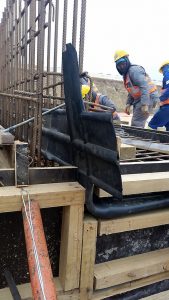
durajoint waterstops, provided by a.b.e. Construction Chemicals, part of the Chryso Southern Africa Group, have been widely used in concrete construction or expansion joints in essential community projects throughout the African sub-continent.

The durajoint waterstop range made from specially-formulated PVC or rubber, has been awarded leading overseas certification, including ASTM and CKS, and Ivor Boddington, a.b.e. Construction Chemicals Technical Manager, says the quality aspect of waterstops should be paramount in selecting such waterproofing products. “All too often, engineers and contractors are swayed by the price of a product and do not consider the profile, thickness, and overall quality of the waterstop to ensure that the specified product will indeed provide the required seal for major water-retaining structures.”
Projects where a.b.e. durajoint waterstops were used to protect the concrete surfaces and joints of waste water treatment works include Vredenburg, Kruisfontein, and Fishwater Flats; and to contain the molten salt that drives the generators at the multi-billion rand Kathu Solar Park in the Northern Cape; as well as for the waterproofing of new water reservoirs currently under construction in various parts of Gauteng. a.b.e. durajoint protection was also used in the building of Eskom’s multi-billion rand Braamhoek Dam hydro-electric scheme and, in Malawi, for a new water treatment plant at Lilongwe, and for the upgrading of the Blantyre Water Board reservoirs.
Boddington says the durajoint waterstop range comprises four products:
- durajoint PVC waterstops which are flexible and easily welded on site to provide the primary seal in the waterproofing of water retaining and/or water excluding structures. They are widely specified to prevent regress or ingress of water or liquids through construction or expansion joints in water-retaining structures such as dams, reservoirs, digesters, water towers, canals, basements, car parks and retaining walls. It can withstand a 10 metre head of water.
- durajoint rubber waterstops, produced in straight lengths and factory-moulded intersections from natural rubber, are flexible enough to accommodate high joint movements of over 10 mm. “These durable rubber waterstops have a ‘memory’ and will return to their natural profiles after long periods of extension, deflection or rapid and repeated movement. They are often applied as a grout check in concrete, double curvature, and arch dams and can withstand a 50 metre head of water,” he explains.
- durajoint SW-B, sodium bentonite (absorbent clay) waterstops seal by immediate swelling and crystallisation, and are used for cold joint sealing of in-situ concrete construction where conventional waterstops are impractical such as in restricted space or access situations. This product is effective for decades and salt-tolerant in concrete and ground water conditions.
- durajoint SW-R Hydrophilic Butyl rubber waterstops are high performance synthetic elastomer strips that seal prefabricated concrete elements such as joints in tunnels and shafts, and may also be used for open joints. “The waterstops’ ‘new generation’ rubber sealing material can expand by up to 400% while still retaining stability. It is ideal for use in tunnels in pressure conditions with up to 5 bar water pressures and, in confined areas, can mould itself to exert pressure evenly on surrounding surfaces – even when these are rough with gaps of uneven size. This means a strong waterproof seal can be achieved without the need for any high compression force,” Boddington adds.
Visit www.abe.co.za for more information

